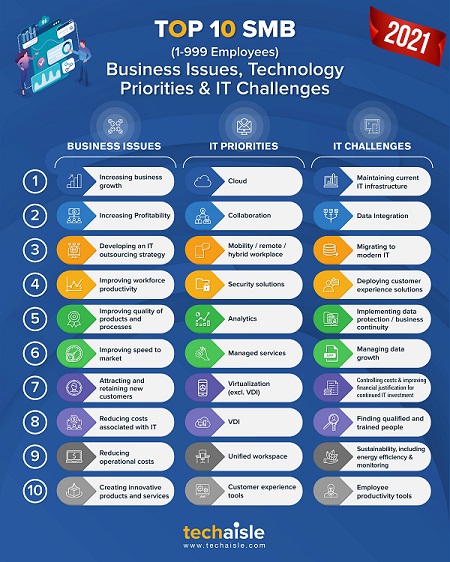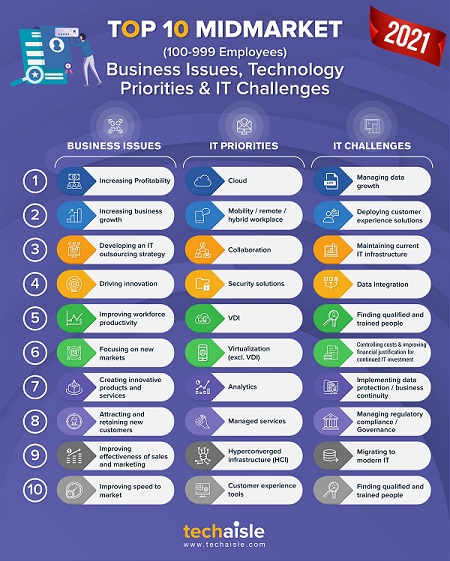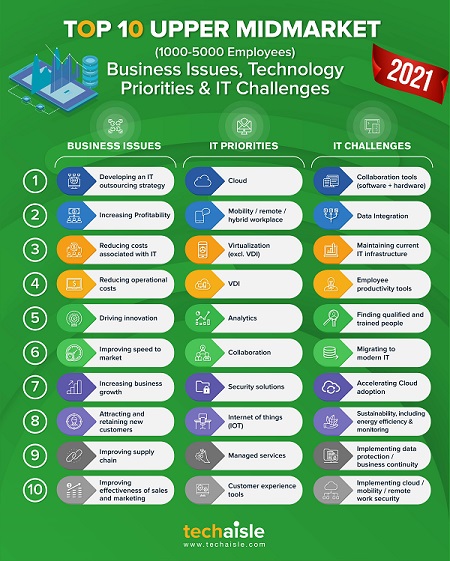New work patterns and the acceleration of distributed workplaces are resulting in a range of productivity benefits for SMBs today. As such, businesses see increased workforce efficiencies and talent recruitment while minimizing cost by reducing intermediaries and integrating contract professionals – and even improved environmental performance through reduced commuting and building footprints.
In the quest to deploy a perfect hybrid workplace technology infrastructure, SMBs often overlook networking – wireless, routers, firewalls, and beyond. Similarly, as small business retailers and other small commercial offices struggle with re-opening uncertainties, they also grapple with the daunting task of enabling secure and safe environments for their employees and customers. Digitization with minimum IT disruption and low manageability is on their minds.
Cash flow constraints, limited access to finances, competitive landscapes, the need for innovation, erratic revenue, uncertainties, the pace of technology change, and many more are drivers for achieving cost efficiencies within SMBs. Digital transformation is no longer the domain of only upper midmarket firms and enterprises. Techaisle's SMB and Midmarket Digital transformation survey research shows that 46% of SMBs are adopting digital transformation to reduce costs, and 38% are planning for innovation in customer engagement and services.
Helping SMBs thrive with robust IT solutions
Unbeknownst to many, the Cisco Meraki platform and the solutions it powers is a critical foundational technology to fast-forward digital transformation for SMBs. Much of this comes from its ease of use, simplicity, and flexibility for lean IT to innovate by doing more with less.
Cisco acquired Meraki in 2012, around the same time (2013), when it divested Linksys to Belkin. Over the years, Cisco has continued to innovate on its highly successful Meraki platform. It is no secret that Cisco Meraki invented cloud-managed networking technology in 2006. It has continued to innovate and expand the networking portfolio to IoT solutions and cover any business need or use case. The Meraki platform consists of switching, security & SD-WAN, wireless access points, mobile device management, and extending to IoT, including smart cameras and AI-equipped sensors to drive business intelligence.
Regarding deep intelligence and analytics, Meraki Health and Meraki Insight allow SMBs to monitor all aspects of their network and applications from the Meraki dashboard or API and easily detect and fix potential issues in minutes. Techaisle's survey shows that only 4% of small businesses have internal full-time IT staff. They spend 79% of their time on support, maintenance, and troubleshooting— creating an IT efficiency deficit and negatively impacting organizational productivity. Meraki Health's objective is to simplify troubleshooting for the lean, almost non-existent, or over-burdened small business owner/manager. Small businesses need to propel growth and enable new business initiatives freeing up time and resources. To ease the digital transformation, Meraki provides many capabilities that protect SMBs of any size, including:
- Preventing cyber-attacks: Meraki MX Security & SD-WAN appliances protect SMB businesses, users, and devices. Meraki security has the backing of Cisco Talos, one of the largest commercial threat intelligence teams globally.
- Deploying remote workers: Meraki Z3 teleworker gateways provide connectivity and secure and seamless in-office experiences. Meraki Insight delivers deep visibility into critical business applications and proactive troubleshooting for remote workers.
- Ensuring safe occupancy: Meraki MV smart cameras let SMBs maintain social distancing guidelines by remotely monitoring and tracking safe occupancy levels in physical environments through intelligent analytics, such as object detection and tracking.
- Cost savings from simplicity: All Meraki products are deployed and controlled from a single pane of glass. Meraki Health is available for all devices, saving many troubleshooting times by pinpointing specific problematic devices and clients via root cause analysis.
SMBs agree that Meraki solutions can be quickly deployed with zero-touch provisioning and configuration and remotely managed through a cloud-based GUI dashboard (single pane of glass), with all-inclusive licensing. Meraki provides 24/7 technical support (email or phone) and a lifetime warranty on devices (except cameras & outdoor APs) with advanced replacement.
Challenges in small business security
Techaisle's SMB security survey research data shows that security is a top IT priority and challenge for 76% of SMBs, and 65% are planning to increase IT security investments. Within the SMB segment, small businesses often lack the skills required to work with software-based security solutions and are 25%-33% less likely than midmarket firms to work with managed service providers.
Most small businesses are not proactive in addressing security issues, but that may not be the whole problem or perhaps even the greatest obstacle to small businesses’ adoption of security technology. Relative to midmarket firms, small businesses have limited to no internal IT security staff, are not generally working with a managed service provider capable of handling security needs, and are about 50% less likely to embrace external vendors' software-based security solutions.
While small businesses could theoretically pursue some strategies used by larger competitors, they lack the experience and skills to identify, deploy, and manage the products and relationships used to develop shields protecting valuable corporate data, applications, and human assets.
Meraki addresses these issues by providing a secure in-office experience to remote workers—giving access to applications while maintaining visibility and control from anywhere with a cloud-managed dashboard. It also encrypts data with Auto VPN, allowing employees to quickly, securely, and remotely connect to corporate locations.
Meraki smart cameras also address physical security, remote monitoring, and intelligence by including on-device storage and flexibility to access data through the cloud. The cameras allow for many playback features with machine learning and AI to compress the data and provide business intelligence instantly gleaned from long recordings. It is an ideal product for SMBs implementing social distancing guidelines, remotely monitoring physical spaces, reducing in-person exposure on-site, and ensuring comprehensive security.
How SMBs can adapt and digitize
As I said earlier, there is increasing importance for innovation and digitization (not referring strictly to the substitution of digital records for physical documents, but more broadly to the use of digital technologies to meet business goals) in SMB strategy. Dependence on technology as a critical element of business success, burgeoning complexity, and cost constraint has created a perfect storm for small businesses to adapt to changing environments using specifically designed technology.
Over the last few months, we studied use cases and Meraki's usefulness within the SMB segment. Meraki addresses real and compelling issues, and I believe it will continue to expand within the SMB community. Verticals such as healthcare, manufacturing, retail, and financial services have been quick adopters of Meraki, specifically for launching new business models, deploying remote workers, transitioning to hybrid workplaces, cybersecurity, location analysis, contact tracing, social distancing, personal safety, curbside pickup, and more.
SMB owners and executives are concerned with issues that extend beyond technology. Yet, today's business environments are increasingly dependent on IT support, products, and services that improve productivity and efficiency or expand market reach and potential.
Final Techaisle Take
IT initiatives that can be linked meaningfully to broader business objectives can attract SMB executive support – meaning that products and services that address key business priorities have the most significant growth potential. Meraki is well on its way.
Today's economy demands that technology support SMB activities. The future will be defined by them capitalizing on technology-enabled business options. If SMBs are thinking about the path forward, from today's foundation to tomorrow's opportunity, they should include Meraki in their evaluations. Writing this analysis reminds me that I work from home and should probably replace my mesh routers with Meraki devices.

















